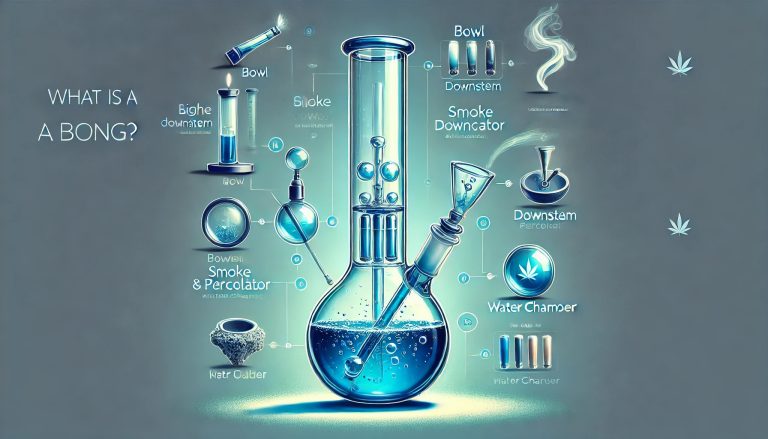
A bong is a special device that is used for smoking cannabis. It is made of glass and with the help of water, the cannabis can be turned into a purified form for smoking. A bong consists of a bowl, water chamber, downstem and a percolator which help in working together to provide a cleaner and smoother smoke.
Jump to Section
Essential Components of a Bong
There are 4 essential components of a bong. Such as:
- Bowl: The bowl of the bong is where the cannabis is combusted and loaded. It is typically made from glass and connects to the downstem, leading to the water chamber. The bowl allows pulling from the downstem to help the fluid dynamic to force the smoke up for inhalation.
- Downstem: Another element of the bong consists of downstem which is a tube in a bong that helps connect the bowl to the chamber of water. It helps in functioning through the use of conduit. This is where the smoke from the bowl travels down to enter the water for filtration. The downstem can easily be removed from the bong and be cleaned for next use.
- Percolator: It is an essential element present in a bong that is designed to diffuse smoke by forcing it through small holes at the end of the downstem. It helps in breaking apart the dense and hot smoke for quick smoking. This process helps in cooling down the smoke as it interacts more with water. This improves the smoothness and taste on the inhale.
- Water chamber: The use of the water chamber is for filtering and cooling down the smoke. When the smoke passes through water it creates bubbles through the percolator. This increases the surface contact and helps in filtering out the impurities in the smoke, if any.
How Do Bongs Work?
Bong cools and filters the smoke with the help of a percolator and water chamber. The smoke passes from the bowl to the water and creates bubbles that increase cooling and filtration. This ascends the neck for a smooth hit. This process leverages diffusion, physics and combustion. Bongs can be found in different sizes, shapes and features that can also impact the overall experience. They can be in different neck lengths, water chamber capacities and percolation systems.
The primary purpose of a bong is to help you take a more concentrated burst of smoke while simultaneously filtering out and cooling down the hot smoke in the water chamber. If the water is not cooled down, it can irritate the lungs and tend to make you feel uncomfortable.
6 Different Phases of the Bong
Phase 1- Combustion- Lighting Up the Bowl
When you begin your bong journey you have a bowl full of packed cannabis. The process starts when the flame touches the bud and causes combustion to occur. It helps in converting the solid flower particles into smoke. The process of combustion helps in releasing the cannabinoids and terpenes from the plant. The heat from the combustion not only helps in vaporizing the compounds but also creates smoke as a byproduct. After extraction, you just have to begin inhaling by pulling the smoke and cannabinoids from the bowl down through the downstem.
Phase 2- Way Through the Downstem
When the smoke is generated in the bowl, your inhale pulls the cannabinoids and terpenes through the downstem of the bong. It is the conduit between the bowl and the water chamber of the bong. When the smoke moves through the downstem, it is funneled into the water below, this contributes to the beginning of water diffusion.
Phase 3- Percolation and Diffusion
The percolator is considered one of the essential components of the bong. The primary purpose of it is to filter out and cool down the smoke. When the smoke travels through the downstem, it travels in one solid stream until it meets the percolator. The percolator helps in splitting the smoke through multiple slits, holes and frits present on the bong.
The smoke is then forced down to split and disperses in smaller streams in the water chamber. The process of splitting the smoke is known as water diffusion. It helps in spreading the hot smoke to cool down before it reaches your lungs.
Phase 4- Bong Water Cooling
When the smoke diffuses into multiple streams the force from your inhale helps in creating bubbles through the percolator’s holes. Every bubble increases the exposure of smoke and helps in splitting of water to further dense out the smoke. This enhances the cooling process. Thousands of micro bubbles are formed and burst which help the smoke to glide across the surface decreasing the temperature of the smoke. When the hot smoke moves through the water, the temperature of the smoke is subtly transferred into the water. This process is known as heat transfer which helps to cool the some down further. The water present in the water chamber helps to pull the heat out of the smoke and cool it down before it reaches your lungs.
Phase 5- Final Ascent Up the Bong Neck
When you pull the bowl out of the downstem, you can change the pressure inside the bong’s water chamber and create a vacuum effect. The sudden shift forces the cooled and filtered smoke up in the bong’s neck at a quicker pace. The bong’s neck acts as the final cooling passage before the smoke tends to reach your lips.
Phase 6- The Bong Rip
The journey of using a bong comes to an end when the smoke exits from the mouthpiece and into your lungs. It helps in delivering the cannabinoids and terpenes in a smooth and flavourful hit known as a bong rip. The entire process of inhaling cannabis from the bong includes heating to inhaling. This is supposed to happen in seconds.
If you are a beginner and consuming cannabis through bong, you must know that it can be an overwhelming process as there are other options and combinations present in the market. You just need to find the best beginner bong that has the perfect water pipe that will fit all your needs.
Significance of Water in Bong
The water that is present in the bong helps to cool down the smoke which in turn helps in smoother inhalation. The water also filters out tar, particulates and ash which reduce the impurities and enhance the flavors. The process improves the overall experience and helps in reducing coughing at times.
Here are some points that make water a significant element in bong:
- It Helps in Cooling Down the Hot Smoke: The water in the bong’s water chamber works as a natural coolant. The heat from combusted cannabis is hot and harsh. The water is used to absorb the heat when smoke is passed through water. It helps in cooling the smoke to a more lung-friendly temperature.
- It Acts as a Filtration Station: The percolator helps in creating bubbles in the water. It helps in dispersing the solid stream of smoke in multiple ways. It helps to trap significant amounts of ash, tar and other particles from the smoke. The smoke is not only cleaner but also allows you to inhale better-quality smoke.
- It Enhances the Flavours: While the overheated smoke can burn off the delicate terpenes and flavonoids, water comes to the rescue. When the heated smoke directly travels into the water chamber, it helps in preserving the natural flavours. This helps in delivering the smoke which is full of flavourful compounds.
- It Plays the Fluid Dynamics: When there is no water in the bong, you can lose the power of fluid dynamics. The fluid dynamics play a crucial role in helping the bong create pressure while you lift the bowl. The water chamber delivers the perfect rip of bong which is dense and fast-moving.
What Happens When You Hit a Dry Bong?
When you try to hit a dry bong, the smoke can be harsh as there is no water to cool down or filter out the impurities. It can irritate your lungs and throat which can lead to uncomfortable bong rip sessions. The top advantage of using a dry bong over a water bong is that it will never get mold because water is needed to grow mold in a bong.
Frequently Asked Questions
1. What Does a Bong Do?
A bong is used to enhance the smoking experience by passing smoke through water. The element of water helps in cooling it down and trapping the impurities present in it. The bubbling takes place due to the percolator and additionally cools and filters out for smoother hit.
2. How Do Bongs Work Scientifically?
Bongs work in a manner to spread smoke through the percolator. It helps in diffusing into finer bubbles which help in filtering out and cooling down. When you remove the bowl, the pressure tends to escape the water chamber and the fluid dynamics propels the smoke up for a bong rip.
3. Do Bongs Filter Smoke?
The water present in the bong acts as a natural filter for ash and tar. Water also helps in cleaning the smoke at a major level but not fully. It does not completely remove all the harmful byproducts but ensures a cleaner and smoother hit.
4. Is a Water Pipe a Bong?
A water pipe is just another term used for a bong. These terms can be used interchangeably. However, when you smoke a bong without water it is considered as a dry pipe.
Final Thoughts
Bongs are not just a classic element of the cannabis culture. The process is full of different dynamics and fluid mechanics that help in delivering the powerful bursts of dense smoke into a smoother experience. Make sure to choose the right bong for an enhanced and flavorful experience.
